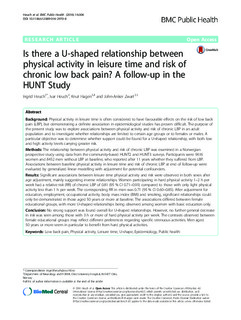| dc.contributor.author | HEUCH, INGRID | |
| dc.contributor.author | Heuch, Ivar | |
| dc.contributor.author | Hagen, Knut | |
| dc.contributor.author | Zwart, John-Anker | |
| dc.date.accessioned | 2020-03-04T12:04:20Z | |
| dc.date.available | 2020-03-04T12:04:20Z | |
| dc.date.created | 2016-04-11T10:52:02Z | |
| dc.date.issued | 2016 | |
| dc.identifier.citation | BMC Public Health. 2016, 16 (306), . | nb_NO |
| dc.identifier.issn | 1471-2458 | |
| dc.identifier.uri | http://hdl.handle.net/11250/2645211 | |
| dc.description.abstract | Background
Physical activity in leisure time is often considered to have favourable effects on the risk of low back pain (LBP), but demonstrating a definite association in epidemiological studies has proven difficult. The purpose of the present study was to explore associations between physical activity and risk of chronic LBP in an adult population and to investigate whether relationships are limited to certain age groups or to females or males. A particular objective was to determine whether support could be found for a U-shaped relationship, with both low and high activity levels carrying greater risk.
Methods
The relationship between physical activity and risk of chronic LBP was examined in a Norwegian prospective study using data from the community-based HUNT2 and HUNT3 surveys. Participants were 9616 women and 8452 men without LBP at baseline, who reported after 11 years whether they suffered from LBP. Associations between baseline physical activity in leisure time and risk of chronic LBP at end of follow-up were evaluated by generalized linear modelling with adjustment for potential confounders.
Results
Significant associations between leisure time physical activity and risk were observed in both sexes after age adjustment, mainly suggesting inverse relationships. Women participating in hard physical activity 1–2 h per week had a relative risk (RR) of chronic LBP of 0.81 (95 % CI 0.71–0.93) compared to those with only light physical activity less than 1 h per week. The corresponding RR in men was 0.71 (95 % CI 0.60–0.85). After adjustment for education, employment, occupational activity, body mass index (BMI) and smoking, significant relationships could only be demonstrated in those aged 50 years or more at baseline. The associations differed between female educational groups, with more U-shaped relationships being observed among women with basic education only.
Conclusion
No strong support was found overall for U-shaped relationships. However, no further general decrease in risk was seen among those with 3 h or more of hard physical activity per week. The contrasts observed between female educational groups may reflect different preferences regarding specific strenuous activities. Men aged 50 years or more seem in particular to benefit from hard physical activities. | nb_NO |
| dc.language.iso | eng | nb_NO |
| dc.publisher | BMC (part of Springer Nature) | nb_NO |
| dc.rights | Navngivelse 4.0 Internasjonal | * |
| dc.rights.uri | http://creativecommons.org/licenses/by/4.0/deed.no | * |
| dc.title | Is there a U-shaped relationship between physical activity in leisure time and risk of chronic low back pain? A follow-up in the HUNT Study | nb_NO |
| dc.type | Journal article | nb_NO |
| dc.type | Peer reviewed | nb_NO |
| dc.description.version | publishedVersion | nb_NO |
| dc.source.pagenumber | 9 | nb_NO |
| dc.source.volume | 16 | nb_NO |
| dc.source.journal | BMC Public Health | nb_NO |
| dc.source.issue | 306 | nb_NO |
| dc.identifier.doi | 10.1186/s12889-016-2970-8 | |
| dc.identifier.cristin | 1349861 | |
| dc.description.localcode | © 2016 Heuch et al. Open Access This article is distributed under the terms of the Creative Commons Attribution 4.0 International License (http://creativecommons.org/licenses/by/4.0/) | nb_NO |
| cristin.unitcode | 194,65,30,0 | |
| cristin.unitcode | 1920,16,0,0 | |
| cristin.unitname | Institutt for nevromedisin og bevegelsesvitenskap | |
| cristin.unitname | Nevroklinikken | |
| cristin.ispublished | true | |
| cristin.fulltext | original | |
| cristin.qualitycode | 1 | |

